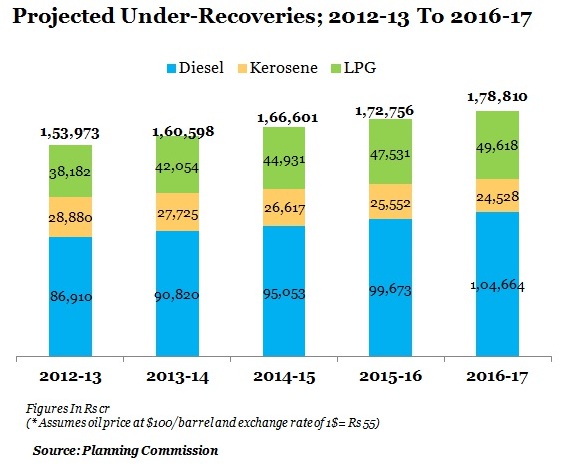In short, the resulting gap between selling
price and market price constitutes under-recoveries.
Why are Under-recoveries controversial ?
- The
quantum of under-recoveries has been a matter of debate for some time
now.
- As
indicated by several committees, the current trade parity pricing method
of calculating under-recoveries, which assigns an 80 per cent weight to
refined product imports and 20 per cent weight to exports may be
overstating the actual burden.
- This
is because, although India imports most of its crude oil, it is an
exporter of refined products such as petrol and diesel, thanks to the
country's surplus refining capacity.
Result:
The under-recovery calculation formula loads import costs such as freight,
insurance, and customs duties on refined products, which may not have been
incurred in the first place.
- Also,
under-recoveries are often confused with losses.
- While
under-recoveries would be incurred if sale price is less than market rates
(which includes margins), loss would be incurred if sale price is less
than cost. In effect, OMCs may be bearing a portion of the under-recovery
burden, yet manage to post profits , as seen in fiscal 2010. Of course, if
under-recoveries to be borne becomes too large, OMCs would slip into the
red.
More transparency in the under-recovery calculations would help
get a correct sense of the real burden.
*************************************************************
India's GoI-PSU Oil Complex
Who the players are, and their role in fuel subsidy
'Upstream' Companies
·
These include companies such as ONGC and OIL, which supply crude to the oil
marketing companies.
· Importantly, they also bear a
significant part of the fuel subsidy by giving discounts on the crude they sell
to the refiners.
· In 2011-12, for instance, such
discounts accounted for about 40% of the total assistance to oil companies.
Oil Marketing Companies
·
The 'refiners-cum-marketers' companies like IOC, BPCL and HPCL(called 'OMCs') buy crude from
upstream companies, and refine it into diesel, petrol and other 'products'.
· The 'refinery' arm of the OMC
then sells it to the marketing arm of the OMC at the international benchmark
price, which sell it to the end-customer.
· By selling at controlled
prices, the marketing arm of OMCs sustain a loss.
Central Government
·
Mobilised about Rs 83,700 crore in taxes on various fuel products
in 2011-12.
· The total subsidy payout, on
the other hand, to the oil companies to compensate them for under-recoveries,
was about Rs 70,000 crore.
· In 2011-12, it bore around half
the total 'under-recoveries' of oil companies.
Recent development !
Under recoveries on diesel to end by mid-2015 : Planning
Commission -
(Note -- Figures are of 2011-12 ....for understanding the concepts ! )


